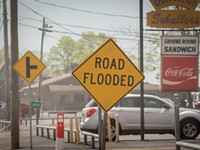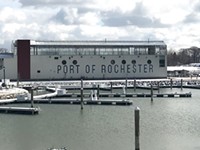[
{
"name": "500x250 Ad",
"insertPoint": "5",
"component": "15667920",
"parentWrapperClass": "",
"requiredCountToDisplay": "1"
}
]
I don't care how fast the frickin' ferry is --- it can't be fast enough for me. LakeOntario is a killer. I've developed a fear of it since learning about the thousands of ships that have sunk in the Great Lakes. And that's if the thing makes it safely out of port. Last week's accident in NYC proves that even though the dangers that lured 18th- and 19th-century ships to their doom are reduced now, boats are still vulnerable to bone-headedness and bad luck.
Just ask Bill Springer, an imaging systems engineer in RIT's School of Photographic Arts and Sciences. His avocation is tracking down and getting images of shipwrecks in the Great Lakes. And there are a lot of them: 6,000 by most counts. One as recently as 1975.
Springer sees only the upside of downed ships. Along with a group called the Great Lakes Shipwreck Historical Society, based in a lighthouse on Lake Superior, Springer spends part of every summer searching for and taking pictures of the nearly 3,000 ships that haven't been found yet. He uses cutting-edge technology like sonar and digital video, and he learns about regional history, climatology, and earth science.
This summer he'll be looking for the British warship Invincible, which sank in Lake Superior in the early 1800s. He'll use old survey maps to find a likely locale for the ship which, after two centuries, is covered with silt. Then he and his colleagues will drag a cesium proton magnometer over the area. "It's basically a giant magnet," he says, similar to the technology the Navy uses to detect enemy subs.
Once a ship is located, Springer uses sonar and underwater robots tricked out with digital cameras on loan from National Geographic to document the wreck. This isn't always easy, but Springer says he enjoys the challenge of "taking information in nontraditional form and making images people can use."
Last summer, he used new sonar technology to get images of the Matheson, a 250-foot-long wooden steamship that was crushed by ice in Lake Superior in 1910. This involved dragging a silver missile-shaped sidescan sonar device which takes "acoustical pictures" over the wreck.
In the Imaging Systems Management lab at RIT, Springer shows me two-foot-long sepia-toned images of the sunken Matheson, its wheelhouse shattered and steam stacks knocked asunder. Debris litters the deck and surrounding lake floor. "These are very high-quality images," Springer says. "No one has ever seen this level of detail at this size."
The images are so good, in fact, that Springer thinks they might have found sunken treasure. "There were rumors about a safe aboard the Matheson," he says, excitedly pointing to a blurred rectangle about 50 feet from the ship. "We believe we found a safe here. At the time there was a gold rush in Minnesota."
Divers beware: Like all GreatLake shipwrecks, the Matheson is protected by state laws. "If you remove any artifact," Springer says, "you can do jail time."
To hear Springer tell it, the Great Lakes are more dangerous than the ocean. "Lake wave patterns are different from ocean patterns," he says. "Lakes slosh back and forth and big waves can reflect off other shores nearby." When two opposing waves meet, he says, they can snap a boat in two.
And, Springer says, the Great Lakes' legendary gales can sweep from the north without warning, driving waves to heights of 40 feet or more. In the days before GPS and radio communications, this spelled doom for unprepared ships. Now, at least, ship-to-shore communiqués can warn captains of heavy weather.
But what about the Edmund Fitzgerald, the 729-foot cargo ship that foundered and sank in wild winds and high seas in 1975? The ship --- made famous by the Gordon Lightfoot song --- was in constant radio communication with a nearby vessel, even as towering waves swept men and equipment from the deck. Modern communications were of no help; all 29 men aboard were lost.
Another unappealing Great Lakes feature is sudden ice formation. That's what happened to the Matheson. The captain dropped anchor to weather out a storm and the boat got iced in. As the crew was scrambling out to safety --- possibly leaving behind a safe full of gold --- the ice closed in and crushed the hull.
Springer and other shipwreck enthusiasts see only one danger in the Great Lakes. For generations, the lakes' clear, cold, and salt-free water has preserved ships, but a new threat lurks: zebra mussels.
"Some 200-year-old sailing ships are in such pristine shape they look like you could pull them up and sail them," Springer says. "But the zebra mussels covering the lakes could make a sunken ship look like a coral reef."
It's a race against time. Working with state grants, Springer and the Great Lakes Shipwreck Historical Society are rushing to find and photograph shipwrecks. He would like to help develop virtual reality tours through the wrecks, so everyone could enjoy them.
Although he's concentrating his efforts on Lake Superior, Springer hopes to start work on LakeOntario as soon as funding is obtained. At the bottom of LakeOntario lie old airplanes --- B-25 bombers flown on WWII training missions, among others --- as well as ships he wants to document.
As for the fast ferry, Springer doesn't think it's in danger of sinking, but he does concede "they're sending that boat into nasty water." When the ferry --- ominously named "Spirit of Ontario" --- pulls out of port, I'll be the one standing firmly on land waving a little hankie. Bon voyage!
Speaking of Fast Ferry, Lake Ontario
-

Calendar preview: Looking up
Aug 19, 2020 -

As Lake Ontario rises, IJC looks to deviate from Plan 2014
Apr 6, 2020 -

Charlotte residents and businesses seek a community vision
Mar 14, 2018 - More »
Latest in Columns
More by Jennifer Loviglio
-
The XX Files
Nov 15, 2006 -

Silent (politically correct) night
Nov 15, 2006 -
Escape to Jennitopia
Nov 1, 2006 - More »





